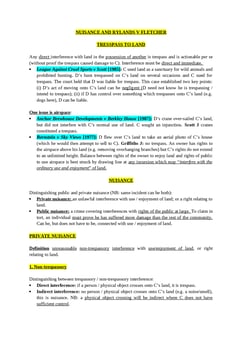- Law Cases
- Tort Law Cases
- Negligence: Duty & Standard of Care; Standard of Care; Cost of Prevention Cases
Baker v Quantum Clothing Group [2011] UKSC 17
By Oxbridge Law TeamUpdated 04/01/2024 07:17
Reviewed ByOxbridge Law Team
Judgement for the case Baker v Quantum Clothing Group
Table Of Contents
KEY POINTS
- The employers were not in breach of their statutory duty because they had complied with the Code of Practice, and this compliance protected them from potential liability under common law for the same period of time.
- The cost of prevention is a relevant consideration in determining the standard of care. If the cost of taking precautions to prevent harm is unreasonably high compared to the magnitude of the risk and the potential harm, the court may find that an employer has met the required standard of care.
- The definition of what constituted "safety" according to section 29(1) of the Factories Act 1961 was not based on an objective standard but rather considered a question for the jury to decide. The determination of safety was to be made by considering all the circumstances at the time, including what could have been reasonably foreseen by the employer.
FACTS
- Mrs. Baker worked in a factory in Sutton in Ashfield, Nottinghamshire, from 1971 to 2001. Between 1971 and 1989, she was exposed to noise levels ranging from 85 to 90 dB(A)lepd, which resulted in some degree of noise-induced hearing loss.
- Mrs. Baker filed a lawsuit against her employers, now known as Quantum Clothing Group Ltd. Other individuals also filed similar claims against different companies, namely Meridian Ltd, Pretty Polly Ltd, and Guy Warwick Ltd.
- The claims were considered test cases and were decided together. Only Mrs. Baker was found to have suffered hearing loss due to workplace noise exposure, and the other claims were dismissed.
- However, Mrs. Baker's claim was subsequently dismissed because her employers were not found to have breached any common law or statutory duty.
- The issue was whether the employer could be held liable under common law negligence or under section 29(1) of the Factories Act 1961 for an employee who experienced hearing loss caused by being exposed to noise levels ranging from 85 to 90dB(A)lepd.
COMMENTARY
- This case highlights the balancing act that courts undertake when determining the standard of care in negligence cases. It demonstrates that the court takes into account factors such as foreseeability, available knowledge, and the cost of prevention when assessing whether the defendant has met the required standard of care.
- The case serves as a precedent for considering the reasonableness of precautionary measures in light of the cost of prevention in negligence claims involving workplace-related harm.
Any comments or edits about this case? Get in touch
For Further Study on Baker v Quantum Clothing Group
Need instant answers? Our AI exam tutor is here to help.
Ask questions 🙋 Get answers 📔 It's simple 👁️👄👁️
Our AI is educated by the highest scoring students across all subjects and schools. Join hundreds of your peers today.
Get StartedSimilar Cases
Related Product Samples
These product samples contain the same concepts we cover in this case.

 Since 2010, Oxbridge Notes has been a trusted education marketplace, supplying high-quality materials from top achievers at universities like Oxford, Cambridge, LSE, Harvard, and Yale.
Since 2010, Oxbridge Notes has been a trusted education marketplace, supplying high-quality materials from top achievers at universities like Oxford, Cambridge, LSE, Harvard, and Yale.